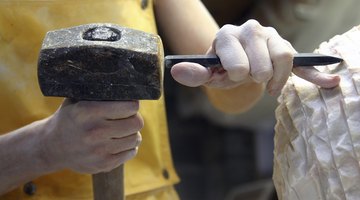Differences Between Alabaster and Marble
Table of Contents
As perennial favorites for sculptors and stone-working companies alike, alabaster and marble are often chosen because of the inherent beauty and workability of both stones. If you haven't had hands-on experience with both materials, it may be easy to confuse the two.

White versions of these stones take on a similar appearance when polished, and both alabaster and marble may contain veins of darker minerals. Even with similar traits, the two materials are vastly different when it comes to hardness and mineral content.
Brittle and Absorbent Alabaster
Alabaster, a fine-grained form of gypsum -- calcium sulfate dihydrate -- is a sedimentary rock made from tiny crystals visible only under magnification. The purest alabaster is white and somewhat translucent, which makes it a beautiful material for carvings and delicate sculptures. Impurities such as iron oxide, or rust, produce spidery veins in the alabaster. Egyptians favored alabaster for making sphinxes, as with the sphinx of Memphis, Egypt, and burial artifacts, such as the lioness-topped alabaster cosmetic jar found in Tutankhamen's tomb. Because alabaster is both brittle and absorbent, it requires extra care and caution when cleaning objects made from it.
Alabaster Care and Cleaning
Clean it only with dry methods, using a soft-bristled brush such as a makeup brush or artist's brush, using care not to allow the brush handle or ferrule to scrape against the object or it may cause a scratch. Wear cotton gloves when handling alabaster, otherwise finger oils left behind may attract dust. Keep alabaster out of humid environments, because this stone absorbs moisture and may become damaged in extremely damp conditions.
Not as Delicate Marble
Marble consists mostly of calcite, or calcium carbonate, different from the gypsum of alabaster. Marble forms when limestone underground is changed through extreme pressure or heat, transforming it into a crystalline structure. Veins in marble come from impurities such as clay embedded within the limestone. The monument to Abraham Lincoln in Washington, D.C. was carved from white Georgia marble, while Renaissance artist, painter and sculptor Michelangelo used Italian Carrara marble in many of his famous sculptures. Marble is not quite as delicate as alabaster when it comes to its care.
Caring for Marble Decor
Dust it with a soft-bristled brush on a regular basis to prevent debris from caking into crevices and carved folds. Marble can handle liquid-based cleaners, but avoid using regular household cleaners or vinegar, as these may etch or otherwise eat away at the material. Use a cleaner especially designed for marble surfaces, such as tabletops and flooring. If your marble item is a valuable antique, forgo the liquid cleaners altogether, in case they discolor the material or remove patina that has built up over the years.
The Hardness Factors
The hardness of stones and minerals, measured by the stones or materials that can scratch others, is one of the methods used in material sciences to determine the relative hardness of stones such as alabaster and marble. Mohs' hardness scale developed by German geologist Frederick Mohs in 1812, rates alabaster and gypsum at 2. Diamonds as one of the hardest minerals, score a 10 on this scale. Calcite -- the mineral group including marble and limestone -- rates a 3 on Mohs' hardness scale, just slightly harder than alabaster. A fingernail is too soft to scratch marble, but a copper penny can easily scratch this material.
The Drip Cap
- As perennial favorites for sculptors and stone-working companies alike, alabaster and marble are often chosen because of the inherent beauty and workability of both stones.
- Clean it only with dry methods, using a soft-bristled brush such as a makeup brush or artist's brush, using care not to allow the brush handle or ferrule to scrape against the object or it may cause a scratch.
- Veins in marble come from impurities such as clay embedded within the limestone.
- Marble can handle liquid-based cleaners, but avoid using regular household cleaners or vinegar, as these may etch or otherwise eat away at the material.
- Mohs' hardness scale developed by German geologist Frederick Mohs in 1812, rates alabaster and gypsum at 2.
- Calcite -- the mineral group including marble and limestone -- rates a 3 on Mohs' hardness scale, just slightly harder than alabaster.
References
Resources
Writer Bio
Kathy Adams is an award-winning writer. She is an avid DIYer that is equally at home repurposing random objects into new, useful creations as she is at supporting community gardening efforts and writing about healthy alternatives to household chemicals. She's written numerous DIY articles for paint and decor companies, as well as for Black + Decker, Hunker, Landlordology, SFGate and others.
Photo Credits
- Mary Gascho/iStock/Getty Images
- Mary Gascho/iStock/Getty Images
More Articles



